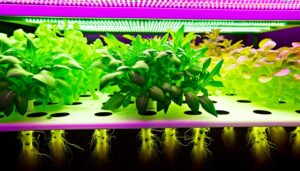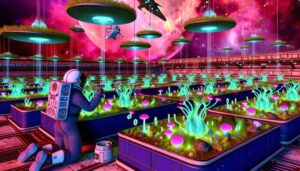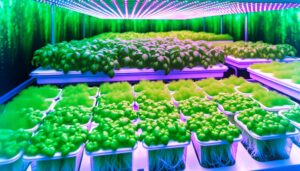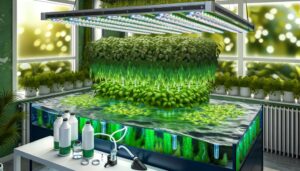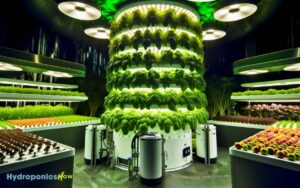How Long Does It Take for Hydroponic Plants to Grow?
In hydroponic systems, plant growth is accelerated due to precise control of nutrients, light, and pH levels.
Lettuce can mature in just 30 days, compared to 45-60 days in soil. Basil takes around 40 days versus 60-75 days, and tomatoes need about 60 days instead of 80-100.
This speed is achieved by optimizing nutrient solutions, balancing light spectrums, and maintaining temperature between 65-75°F.
Such conditions create an ideal environment, leading to 30-50% faster growth than soil-based gardening. For more insights into achieving the best results, explore the nuances of hydroponic techniques and environmental management.
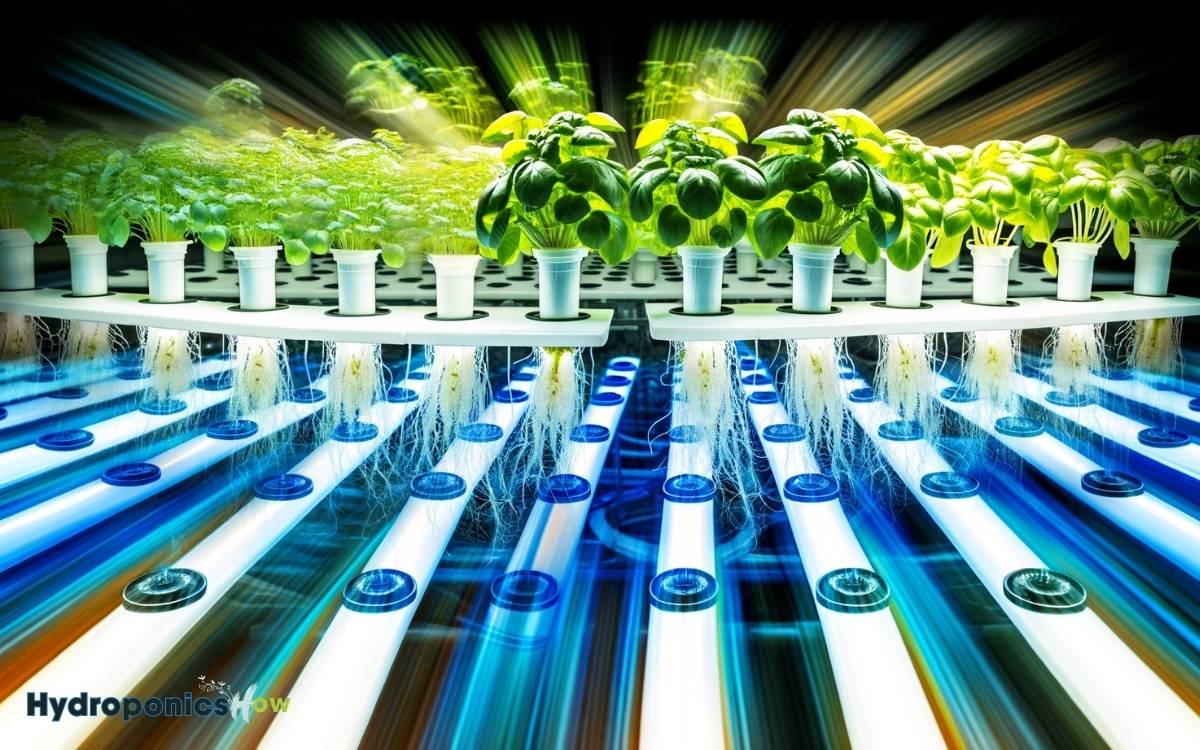
Key Takeaways
Factors Influencing Growth
When it comes to hydroponic plant growth, several key factors play essential roles in determining the speed and health of plant development.
Nutrient availability is crucial in maintaining a precise balance, as plants in hydroponic systems rely solely on the provided solution for their nutritional needs.
Light intensity must be carefully regulated to mimic natural sunlight, as it’s important for photosynthesis.
Maintaining the ideal water pH is crucial; too acidic or too alkaline conditions can hinder nutrient absorption.
By closely monitoring these parameters, you can optimize the growth environment, resulting in healthier, faster-growing plants.
Understanding these factors allows you to make informed adjustments, ensuring your hydroponic system functions at its best.
Hydroponics Vs. Soil
Comparing hydroponics to traditional soil gardening reveals distinct advantages and challenges in plant growth efficiency and yield. In hydroponics, plants grow faster due to optimized conditions. You control every aspect, from light to nutrients, ensuring maximum efficiency.
Here are three key differences:
- Growth Speed: Hydroponic plants often grow 30-50% faster than soil plants due to direct nutrient access.
- Space Efficiency: Hydroponic systems can be vertical, maximizing space use, unlike sprawling soil gardens.
- Water Usage: Hydroponics uses up to 90% less water than soil gardening, as water recirculates in a closed system.
However, hydroponic systems can be more complex and costly to set up. Understanding these differences helps you choose the best method for your gardening needs.
Nutrient Solutions
You’ll need to focus on the essential nutrient components to guarantee excellent plant growth in hydroponics.
It’s vital to maintain the solution’s pH balance, as it directly affects nutrient absorption.
Essential Nutrient Components
To guarantee ideal growth in hydroponic systems, it’s important to provide plants with a well-balanced nutrient solution that includes essential macro and micronutrients.
These components play a critical role in various physiological processes:
- Macronutrients: Nitrogen (N), Phosphorus (P), and Potassium (K) are essential for leaf development, root growth, and overall plant health.
- Secondary Nutrients: Calcium (Ca), Magnesium (Mg), and Sulfur (S) aid in cell wall structure, photosynthesis, and enzyme functions.
- Micronutrients: Elements like Iron (Fe), Manganese (Mn), and Zinc (Zn) are needed in trace amounts but are necessary for enzyme activation and chlorophyll synthesis.
Ensuring a proper balance of these nutrients will allow your hydroponic plants to thrive, maximizing their growth rates and yields.
Solution Ph Balance
Maintaining the right pH balance in your nutrient solution is essential for maximizing nutrient uptake by hydroponic plants.
Ideally, you should aim for a pH range between 5.5 and 6.5. At this range, essential nutrients like nitrogen, phosphorus, and potassium remain soluble and accessible to plant roots.
If the pH strays outside this range, nutrient absorption can be severely hindered, causing deficiencies or toxicities. Regularly monitor the pH using a reliable meter and adjust as needed with pH up or down solutions.
Light Requirements
Understanding the light requirements for hydroponic plants is essential for optimizing their growth and maximizing yield.
You need to take into account three primary factors:
- Light Intensity: Make sure your plants receive adequate light, typically measured in lumens. Too little light can stunt growth, while too much can cause leaf burn.
- Light Spectrum: Plants utilize different wavelengths for various growth stages. Blue light (400-500 nm) promotes vegetative growth, while red light (600-700 nm) is vital for flowering.
- Photoperiod: The duration of light exposure affects growth cycles. For instance, most vegetables need 14-18 hours of light per day for the best development.
Temperature Control
When managing the temperature for hydroponic plants, it’s crucial to maintain an ideal range that supports both root and foliage development, typically between 65-75°F (18-24°C). This temperature range optimizes enzymatic activities and nutrient uptake.
If temperatures fall below 65°F, plant growth rates can slow, and nutrient absorption might be impaired. Conversely, temperatures exceeding 75°F can lead to root diseases and reduced oxygen levels in the nutrient solution.
You’ll need to monitor ambient conditions and employ heating or cooling systems as necessary. Utilizing digital thermometers and automated climate control systems can help maintain consistency.
Plant Varieties
When considering hydroponic gardening, you’ll find that different plant varieties exhibit varying growth rates. Popular choices like lettuce and basil grow rapidly, while others like tomatoes and peppers have longer maturation periods. This variation in growth speed is influenced by factors such as nutrient availability, light exposure, and temperature control. Many growers wonder, do hydroponic plants grow faster than their soil-grown counterparts? In most cases, the controlled environment of hydroponics allows for quicker growth and higher yields, making it an attractive option for gardeners.
Analyzing these differences helps you optimize your hydroponic system for both efficiency and yield.
Popular Hydroponic Plants
Popular hydroponic plants, such as lettuce, basil, and tomatoes, thrive in nutrient-rich solutions and demonstrate rapid growth cycles that are markedly shorter than their soil-grown counterparts.
These plants benefit from controlled environments, ensuring ideal growth conditions.
Consider these three popular choices:
- Lettuce: Known for its fast growth, you can harvest hydroponic lettuce in about 30 days.
- Basil: This herb flourishes quickly in hydroponic setups, often ready for harvest in about 28 days.
- Tomatoes: Though they take slightly longer, hydroponic tomatoes mature faster than soil-grown ones, typically within 60-80 days.
Growth Rate Differences
Examining the growth rate differences among various hydroponic plant varieties reveals significant variations influenced by genetic factors, nutrient solutions, and environmental control.
You’ll notice that leafy greens like lettuce grow faster than fruiting plants like tomatoes. This is due to their simpler nutrient requirements and shorter life cycles.
Here’s a comparative table:
| Plant Variety | Growth Time (Weeks) |
|---|---|
| Lettuce | 4 – 6 |
| Basil | 6 – 8 |
| Tomatoes | 8 – 12 |
Lettuce benefits from rapid nutrient uptake and efficient light use. Basil requires slightly more time due to its denser foliage.
Tomatoes, needing complex nutrient mixes and stable conditions, take the longest. These differences highlight the necessity of tailored care for each plant type to optimize growth rates in hydroponic systems.
Growth Stage Timeline
Understanding the growth stage timeline in hydroponic plants involves analyzing key developmental phases, from germination to harvest, each influenced by specific environmental factors and nutrient availability.
You’ll need to monitor these stages closely:
- Germination: Seedlings sprout within 3-10 days, depending on species and ideal conditions like temperature and moisture levels.
- Vegetative Stage: Plants focus on leaf and root development, lasting 3-6 weeks. Light intensity, nutrient concentration, and pH levels play significant roles.
- Flowering and Fruiting: This final stage spans 4-12 weeks, where plants develop flowers and fruits. Nutrient solutions rich in phosphorus and potassium are essential.
Each phase demands precise adjustments to light, nutrients, and environmental conditions to ensure optimal growth and yield.
Common Growth Rates
In hydroponic systems, growth rates can vary considerably depending on species, environmental controls, and nutrient management, typically resulting in faster development compared to traditional soil cultivation.
For instance, leafy greens like lettuce can mature in as little as 30 days, whereas tomatoes may take up to 60 days to reach peak growth. Herbs such as basil usually fall in between, often ready in about 40 days.
This acceleration is primarily due to the direct access to nutrients and water, coupled with the ability to finely tune environmental conditions.
| Plant Type | Hydroponic Growth Time | Soil Growth Time |
|---|---|---|
| Lettuce | 30 days | 45-60 days |
| Basil | 40 days | 60-75 days |
| Tomatoes | 60 days | 80-100 days |
This table illustrates how hydroponic systems can significantly reduce growth time.
Optimizing Growth Conditions
To optimize growth conditions in hydroponic systems, you need to meticulously control factors like light intensity, nutrient concentration, and pH levels. Ensuring these parameters are within ideal ranges will greatly impact plant health and growth rates.
- Light Intensity: Provide 14-16 hours of light per day using LED grow lights, ensuring a balance between red and blue wavelengths.
- Nutrient Concentration: Maintain a nutrient solution with balanced macronutrients (N, P, K) and micronutrients, adjusting according to plant growth stages.
- pH Levels: Regularly monitor and adjust the pH to stay between 5.5 and 6.5, as this range maximizes nutrient uptake.
Conclusion
To sum up, you can greatly accelerate plant growth using hydroponics compared to soil. For example, lettuce grown hydroponically reaches maturity in just 30 days, as opposed to 60 days in soil.
By carefully managing nutrient solutions, light, and temperature, you can optimize conditions for faster growth.
Keep in mind, specific plant varieties and their growth stages will also impact timelines.
With these scientific techniques, you’re well-equipped to achieve remarkable results in your hydroponic gardening endeavors.


